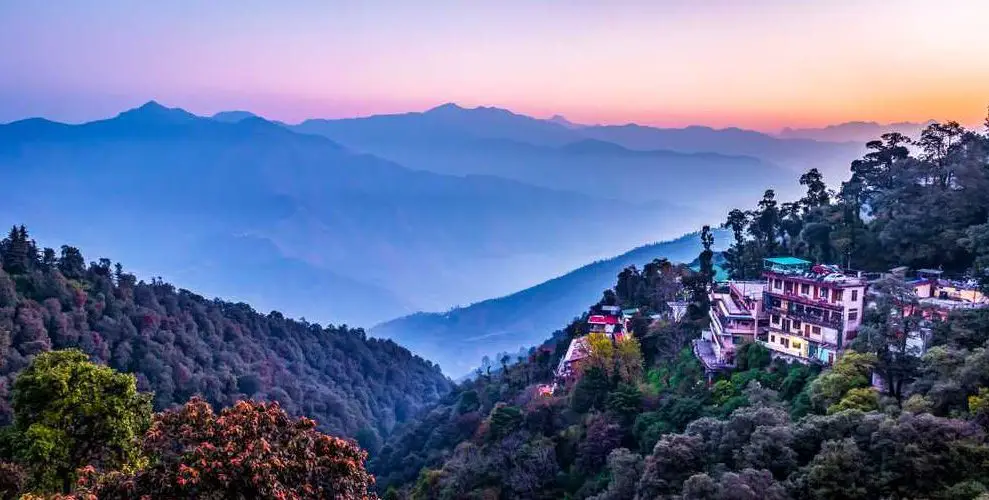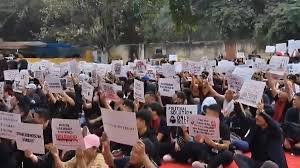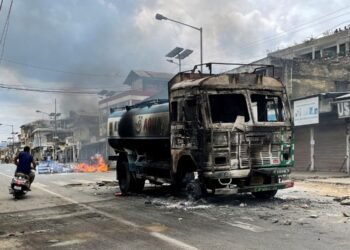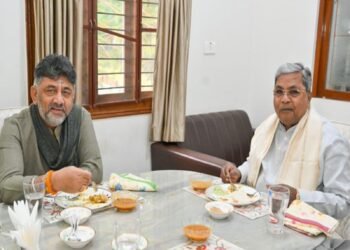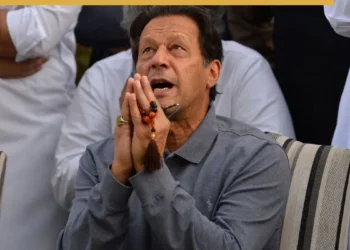Editor’s Note: On the second anniversary of the tragic events in Manipur (May 3, 2023), The Power Corridors invites perspectives from all sides of the ongoing conflict. As part of this initiative, we present an article by Uday Reddy, a UK-based professor of computer science at the University of Birmingham, who has actively contributed to online discussions on the Kuki-Meitei conflict. To share your views, email: novinkn@gmail.com. We plan to compile submissions and forward them to the Ministry of Home Affairs—amplifying voices from Ground Zero.
Manipur conflict, where do we go from here?

BY Prof. Uday Reddy
The May 3 eruption of the Manipur conflict was by no means sudden. It had been simmering for several years and had already intensified by March 2023. Two full months before May 3, then Chief Minister Biren Singh cracked down on a protest rally by the Kuki-Zo people, branding it unconstitutional. He also alleged that the protesters were instigated by SoO groups (Kuki militant groups under the Suspension of Operations agreement), and subsequently withdrew Manipur’s participation from the SoO agreement. The broader history that led up to these events was largely overlooked in news coverage of the violence. Understanding this full history is essential to charting a viable course forward.
The first development that comes to mind is the xenophobic Inner Line Permit system movement. It reportedly went on for 12 years, during which all “mainland” Indians living in Manipur were demonised as interlopers and exploiters, and many were attacked and killed. The production of fake demographic data was also refined into a fine art during this time. The Meitei organisation, United Committee Manipur (UCM), claimed to have done an analysis of 2001 census and came up with a figure of 7.04 lakh “migrants” in Manipur, supposedly more than the entire tribal population of the state. But looking into the census data, we find only 1.6 lakh speakers of non-Manipur languages in 2001. Babloo Loitongbam inflated the figure further to 10 lakh in an interview with The Wire. When it comes to Manipur, it appears that the extremists and the moderates sing from the same hymn sheet.
One of the ideas that got polished during this period is that of “indigenous people” of Manipur, called “Yelhoumee” in Meiteilon, equivalent to “Bhumiputras” used in Assam. An organisation called International Meetei Forum (IMF) claimed that only the Meiteis and the Nagas were indigenous to Manipur, the Kukis were not. Testimonials from former British Raj officers were cherry-picked to theorise that Kukis were foreigners in Manipur, having supposedly came from “Myanmar”. Never mind that there was no such thing as “Myanmar” at the time, nor did the present-day borders of Manipur exist. But, saying is believing and thinking is believing in Manipur’s post-truth world.
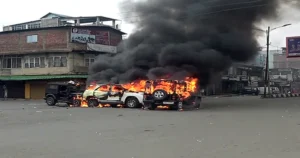
ALSO READ: Audio labs work in days, so why months for Biren Singh tape?
The fact is that the Manipur state had no influence in the southern hills of present-day Manipur during the early days of British Raj. Those hills were much part of “Myanmar”, as they might call it. The southern frontier of Manipur was at a hill called “Tseklapai” near present-day Torbung. This is documented in the Manipur kings’ chronicle, Cheitharol Kumbaba as well as British reports. It was only around 1900, after the British had already subdued the present-day Mizo Hills and Chin Hills, that Manipur’s southern border was extended to the present-day border near Chivu salt sprints. So if Kukis show up very little in Manipur’s historical records, it is not because Kukis were new to Manipur, rather it was because Manipur was new to the Kuki Hills.
Disregarding all these subtleties of history, Kukis were branded as foreigners in Manipur, not only by IMF, but a plethora of other Meitei nationalist organisations including Federation of Haomee, United Committee Manipur, and lately COCOMI. The claim was repeated numerous times in the course of the conflict, and it continues to be peddled even today.
Must Read: Manipur Hills: Costly Trek Home Beats Paradise Flight
Undoubtedly, the Manipur valley constitutes only 10 percent of the land area of the state and the hills constitute the remaining 90 percent. This does not automatically imply that the hills are abounding in land. The worldwide average of inhabitable land in hill regions is only 7 percent. The inhabitable land in the hills lies on the hill tops (or ridge tops) and the valleys embedded in the hills. Historically, the Kukis tended to live on hill tops. They believed that lower elevations were unhealthy for them. But hilltop locations are narrow spaces, which can only accommodate a dozen or so houses each. One cannot have modern amenities such as roads, schools and hospitals in such small remote spaces, let alone internet and mobile connectivity. For this reason, the younger generations have been increasingly moving down to the valley regions where they can avail of education, jobs and modern economy. But it is precisely these valleys that the Meiteis want to occupy, claiming that all of “valley” belongs to the Meiteis and only “hills” belong to the tribals. This essentially means shutting off all development from the tribals, a completely unacceptable proposition.
The second facet of the land contestation is the Meitei belief that the present-day Manipur is their ancient inheritance. “Our forefathers have sacrificed their lives for it,” claimed Biren Singh. In this view, the entire territory of present-day Manipur is the ancient domain of the Meiteis, and it was only through the largesse of their kings that the Kuki tribals have been allowed to live there. Once again, it is a post-truth world!
ALSO READ: The Horror of May 3, 2023, and Way Ahead: WL. Hangshing
According to the Manipur Land Revenue & Land Reforms Act (MLR&LR Act) passed by the Indian Parliament before Manipur became a state, land cannot be transferred from a tribal person to a non-tribal person without the permission of district authorities. This is the only feeble protection the tribals have for their traditional land. But this protection has been circumvented in numerous ways by the Meitei community with the support of the Meitei-dominated state. One means is to forcibly survey the valley areas and convert it into patta land so that individual sale becomes possible. The surveyed areas are then surreptitiously added to valley districts in a salami slicing tactic we are familiar with from China. Another means is to get a tribal chief to mortgage his land to a Meitei cooperative society, which is then allowed to be forfeited after a period of six months, with no questions asked. Sometimes, the Meiteis have also begged the Kuki village chiefs for land to accommodate refugees from Bangladesh, and all those lands have now become sprawling Meitei villages, despite them having been listed as hill villages in the Gazette of Manipur in the 1950s. Many of such places were sites of intense battles during the present conflict.
A third facet of land contestation is that of reserved forests, which will bring us to March 2023. The idea of declaring forest stretches as Protected Forests or Reserved Forests was established during British colonial rule. Contrary to popular belief, the motivation was not forest conservation, but rather their “managed exploitation”. Not surprisingly, the areas that were sought for exploitation were those close to the Manipur valley. For the Kukis, these same areas close to the valley were their prime real estate, from where they could access the development in the valley, such as schools and hospitals.
Very likely, the under-educated Kuki tribals had only a vague idea of what was being done to the forests that were their homelands by arbitrary fiat of law. They continued to live as they had always lived except when the forest authorities hampered them in some way. One of the traditional practices of Kukis has been to spin off new villages (called machete, bifurcation) when the existing villages get sufficiently large. This is part of their custom. It might also be necessary on practical grounds since their villages cannot grow indefinitely in the narrow spaces they lie in. Forest authorities had apparently permitted such bifurcation in the decades past, and the offshoot villages had been registered by the revenue department and taxes had been collected.
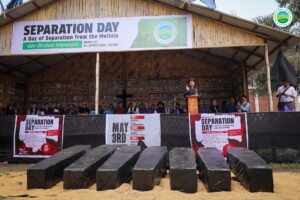
The Biren Singh government initiated a crackdown on such offshoot villages in 2022, and demolished a 16-family village called K. Songjang, which it claimed had been established only the previous year. It also sent show-cause notices to many others. In addition, it also claimed to have conducted a review of all Kuki villages in the Thangjing Hills area which comes under the Churachandpur-Khoupum Protected Forest, and declared permissions issued for them in the 1970s were improper, and unilaterally cancelled them. It announced that similar considerations will apply to all other protected forests in the state as well. This is what got the Kukis up in arms in late 2022, and led to the protest marches in March 2023.
The Scheduled Tribe demand of the Meiteis came on top of all these targeted attacks and represented yet another form of land contestation. If the Meiteis could get themselves declared as Scheduled Tribes, the protections in place for the tribal lands become toothless, and the Meiteis can expand into tribal lands at will. This was the final stage of the onslaught that led to the eruption of Manipur violence on May 3, 2023.
One other issue we should touch upon is that of tribal autonomy. All over Northeast India, the Sixth Schedule of the Indian Constitution is the norm for tribal self-governance. But Meiteis have always been loathe to acquiesce to the power-sharing implied by it. Perhaps they were also guided by the irredentist visions of an ancient Meitei state that covered all of present-day Manipur. Nevertheless, the Union government in its talks with the SoO groups zeroed in exactly a package equivalent to the Sixth Schedule. A “Bodoland-like territorial council” was mentioned in news reports. According to the Kuki Organisation for Human Rights (KOHUR), in a crucial meeting on 3 May, the package was agreed and the agreement was to be signed later that week. However, Chief Minister Biren Singh, when he heard about the agreement, got angry and decided to launch the Manipur conflict.
ALSO READ: Seilen Haokip’s Column: Manipur — Two Years on: A Federated Way Forward for Lasting Peace
Once the conflict erupted, Meitei hate speech hit the roof. On May 3 itself, murderous Meitei mobs were shouting “Kukis are not Manipuris”, “Kill them all”. The chief minister himself propagated labels like “poppy cultivators”, “illegal immigrants” and “forest encroachers”, to which COCOMI added the label “narco-terrorists”. In the numerous Meitei protests held on streets, Meitei school children were seen shouting slogans like “Annihilate the Kukis”, “pick them up like insects and throw them out”. Genocidal songs were composed and sung. Every attack on Kuki villages that resulted in deaths and dismemberment was celebrated as a Meitei national achievement.
So, how do we roll back all this hate now? The removal of Chief Minister Biren Singh from office is hardly enough. Where are the signs of reform or the stirrings of a conscience within Meitei society? The chief of FOCS (Federation of Civil Society Organisations), who had announced a “peace march” to unite the hills and the valley on March 8, was himself found delivering exclusivist hate speeches, claiming that Manipur belongs only to the Meiteis and Nagas. He was eventually forced to step down in disgrace. Meanwhile, COCOMI has refused to attend the peace talks convened by the Union government, arguing that issues such as “illegal immigration” and “narco-terrorism” remain unaddressed. Worse, it has reiterated its stance that the central government is a party to the conflict, allegedly using “Chin-Kuki extremists” as its proxies.
So, the professed Meitei desire for peace rings hollow. What they are demanding is not peace, but submission. They want Kuki-Zo citizens to return to the Imphal Valley and accept the diktats and extortion of Arambai Tenggol, Meitei Leepun, and the numerous insurgent groups entrenched in the valley. They seek to maintain the same old unequal distribution of power and resources that keeps the Kuki-Zo and other tribal communities marginalized and backward. It doesn’t take a genius to see that such a scenario is highly unlikely to unfold.
The ball is in the Meiteis’ court. As the state’s dominant group, they hold the power to choose between peace and war. If they truly seek peace, it must begin with honest soul-searching: a renunciation of extremist and supremacist ideologies, an unequivocal condemnation of majoritarian hate campaigns, and a clear call to disband militias like Arambai Tenggol and Meitei Leepun. Above all, there must be an acknowledgment of the real facts behind the Manipur violence—facts that were systematically suppressed by the Meitei-centric Imphal media and the Meitei-dominated Biren Singh government.
If none of this happens, then the break-up of the state may be the only answer. The time to wake up is now.


